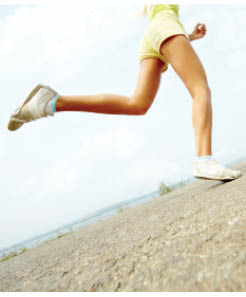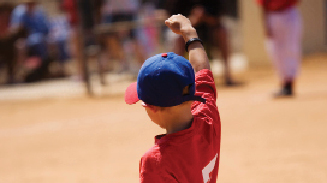History and Presenting Symptoms
The patient is a 13-year-old boy who was identified at a school screening to have a discrepancy in his shoulder heights. His parents were advised to contact an orthopedic surgeon for further evaluation. They reported that the orthopedist found evidence of a scoliosis, but recommended a “watch and wait” approach. No treatment was offered, but if the boy’s spinal curve increased, he (the orthopedist) would be available to perform spinal corrective surgery. The boy’s parents are requesting a second opinion, and any recommendations for non-invasive, conservative care. The patient has no back symptoms, and neither he nor his parents recalls any back injury. He is regularly active in several physical activities, including softball and swimming.
 Exam Findings
Exam Findings
Vitals. This 5’4’’ tall, athletic 13-year-old boy weighs 112 lbs, which results in a BMI of 19.2 – he is within the healthy range.
Postural examination. Standing postural evaluation identifies a left low pelvis, and a right low shoulder. His knees are well-aligned, but he has an obvious medial bowing of the left Achilles tendon, with a lower medial arch on the left foot.
Chiropractic evaluation. Motion palpation identifies several mild limitations in spinal motion: the left SI joint, the lumbosacral junction, T11/12, and at the cervicothoracic junction. Palpation finds no local tenderness in these regions, and he has full and pain-free active spinal ranges of motion. Thoraco-lumbar lateral bending is equal for both sides, and the Adams forward bending test finds no evidence of rib hump or persisting curve.
Lower extremities. Closer examination finds that the left medial arch of the foot is lower than the right when standing. When he is seated and non-weightbearing, the left arch appears equal to the right. And when he performs a toe-raise while standing, the left arch returns. Manual muscle testing finds no evidence of muscle weakness in the peroneal or anterior tibial muscles.
Imaging
A P-A full-spine film demonstrates a C-curve scoliosis, which encompasses the lumbar and thoracic regions. The sacral base is lower on the left by 3 mm, and the Cobb angle is 12°. A collimated pelvic view with the femur heads centered finds a difference of 6 mm in the heights of the femur heads, with the left side lower.
Clinical Impression
Here we have a classic case of a functional scoliosis associated with a unilateral flexible flat foot. By definition, this eliminates the concern of a progressive idiopathic scoliosis, which had given the parents cause for worry. The condition is accompanied by multiple areas of mild joint motion restriction and compensatory spinal fixations.
Treatment Plan
Adjustments. Specific adjustments for the lumbopelvic and thoracolumbar spinal regions were provided as needed. Manipulation of the left foot, including the navicular and cuboid bones, was performed.
Support. Individually designed stabilizing orthotics were provided to ensure balanced support for both arches and to reduce weight-bearing asymmetry. Particular emphasis was placed on wearing the supports in his athletic shoes.
Rehabilitation. Because of his age and athletic pursuits, no specific rehabilitation exercises were provided. He was able to continue in his sports activities without difficulty.
Response to Care
All spinal and foot adjustments were well tolerated, since he was young and symptom free. The orthotics improved his postural misalignment and eliminated the shoulder discrepancy. After two months of care, repeat full-spine x-rays with his orthotics in place found only a minimal (3 mm) leg length discrepancy, a level sacral base, and a 6° Cobb angle (which is considered non-scoliotic). He was released to a self-directed home stretching program after a total of eight treatment sessions over two months.
Discussion
This active 13-year-old boy responded well to a combination of spinal adjustments and stabilizing orthotics. Although he was asymptomatic, his parents worried about him being a potential candidate for spinal surgery, based on the specialist’s opinion. Chiropractic evaluation found his scoliosis to be functional, and his flat foot was found to be flexible. Appropriate conservative care was initiated, and was ultimately very successful. In most cases, a functional scoliosis responds well to chiropractic care, and is unlikely to require surgery.
 Vitals. This active woman weighs 154 lbs, which at 5′6″ results in a BMI of 24.9—she is right on the normal/overweight borderline. She mentions that she has lost about 14 lbs since beginning regular running, and hopes to lose about 10 more (which would be appropriate for her height). She reports that she has never smoked, and that her blood pressure and pulse rate are both at the lower end of normal range. She drinks one to two glasses of white wine each week, usually with meals.
Vitals. This active woman weighs 154 lbs, which at 5′6″ results in a BMI of 24.9—she is right on the normal/overweight borderline. She mentions that she has lost about 14 lbs since beginning regular running, and hopes to lose about 10 more (which would be appropriate for her height). She reports that she has never smoked, and that her blood pressure and pulse rate are both at the lower end of normal range. She drinks one to two glasses of white wine each week, usually with meals.
 Vitals. This active woman weighs 154 lbs, which at 5′6″ results in a BMI of 24.9—she is right on the normal/overweight borderline. She mentions that she has lost about 14 lbs since beginning regular running, and hopes to lose about 10 more (which would be appropriate for her height). She reports that she has never smoked, and that her blood pressure and pulse rate are both at the lower end of normal range. She drinks one to two glasses of white wine each week, usually with meals.
Vitals. This active woman weighs 154 lbs, which at 5′6″ results in a BMI of 24.9—she is right on the normal/overweight borderline. She mentions that she has lost about 14 lbs since beginning regular running, and hopes to lose about 10 more (which would be appropriate for her height). She reports that she has never smoked, and that her blood pressure and pulse rate are both at the lower end of normal range. She drinks one to two glasses of white wine each week, usually with meals.


 Exam Findings
Exam Findings
 Vitals. This athletic young male weighs 175 pounds, which at 5’11’’ results in a BMI of 24.4: He is not overweight. He is a non-smoker, does not drink alcohol, and his blood pressure and pulse rate are at the lower end of the normal range.
Vitals. This athletic young male weighs 175 pounds, which at 5’11’’ results in a BMI of 24.4: He is not overweight. He is a non-smoker, does not drink alcohol, and his blood pressure and pulse rate are at the lower end of the normal range.

 This female patient is a 51-year-old small business owner and exercise enthusiast. She reports pain in the front of her left knee over the past several months, especially when exercising at the gym. She has no obvious swelling or discoloration and denies any specific injury. She reports that she takes over-the-counter medication for relief, but is worried about taking drugs in order to complete her exercise regimen.
This female patient is a 51-year-old small business owner and exercise enthusiast. She reports pain in the front of her left knee over the past several months, especially when exercising at the gym. She has no obvious swelling or discoloration and denies any specific injury. She reports that she takes over-the-counter medication for relief, but is worried about taking drugs in order to complete her exercise regimen.
 The patient is a 44-year-old male who describes persistent pain and occasional stiffness in his right knee that is not associated with any specific activity. He reports at least two years of recurring episodes of medial knee pain that just comes and goes with no swelling or inflammation. Previous evaluations, including a knee MRI, have resulted in a diagnosis of a torn meniscus. Surgery has been offered; but with no guarantee of significant pain reduction, he has declined to undergo arthroscopic repair.
The patient is a 44-year-old male who describes persistent pain and occasional stiffness in his right knee that is not associated with any specific activity. He reports at least two years of recurring episodes of medial knee pain that just comes and goes with no swelling or inflammation. Previous evaluations, including a knee MRI, have resulted in a diagnosis of a torn meniscus. Surgery has been offered; but with no guarantee of significant pain reduction, he has declined to undergo arthroscopic repair.
 Exam Findings
Exam Findings
 Mr. S. is a well-known golfer in our area. He is 60 years of age, has won several county senior titles and has played at a very competitive level for many years. He presently plays at a “scratch” handicap. Mr. S. has been a patient for a number of years and has always understood the importance of regular chiropractic adjustments and exercise. Early this spring, he came to us with a new complaint of pain in his left low back area radiating into his left hip. Pain was also noted in the area along the lateral tibia of the left leg and continued pain over the lateral aspect of the foot. Mr. S. also feels that when he walks he is placing more pressure down on the left foot.
Mr. S. is a well-known golfer in our area. He is 60 years of age, has won several county senior titles and has played at a very competitive level for many years. He presently plays at a “scratch” handicap. Mr. S. has been a patient for a number of years and has always understood the importance of regular chiropractic adjustments and exercise. Early this spring, he came to us with a new complaint of pain in his left low back area radiating into his left hip. Pain was also noted in the area along the lateral tibia of the left leg and continued pain over the lateral aspect of the foot. Mr. S. also feels that when he walks he is placing more pressure down on the left foot. 
 Exam Findings
Exam Findings
 I get numerous emails from doctors who have questions regarding plantar fascia conditions. It is a common ailment for runners, but anyone can develop plantar fascitis. You probably have more patients with plantar fascia problems than you realize because the first signs and symptoms are usually foot pain with difficulty walking when arising out of bed in the morning. Once they have walked a little the pain usually resolves. When they come into our offices later in the day for their other complaints, they might not mention the condition.
I get numerous emails from doctors who have questions regarding plantar fascia conditions. It is a common ailment for runners, but anyone can develop plantar fascitis. You probably have more patients with plantar fascia problems than you realize because the first signs and symptoms are usually foot pain with difficulty walking when arising out of bed in the morning. Once they have walked a little the pain usually resolves. When they come into our offices later in the day for their other complaints, they might not mention the condition. 
 Exam Findings
Exam Findings Adjustments. Specific side-posture adjustments for the left sacroiliac joint were provided. Manipulation of the left navicular and calcaneal bones was performed to reduce the biomechanical stress on the medial arch and sub-talar joint.
Adjustments. Specific side-posture adjustments for the left sacroiliac joint were provided. Manipulation of the left navicular and calcaneal bones was performed to reduce the biomechanical stress on the medial arch and sub-talar joint.